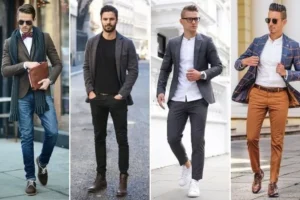Your cart is currently empty!

Fashion for Men in the 1950s: Casual to Formal Styles
I
The era when men’s fashion started to change very rapidly, blending classic tailoring style with up-and-coming trends for a much more casual look. The postwar optimism, Hollywood playing a role and a burgeoning consumer culture led to a polished but casual attitude toward menswear. The 1950s were a transformative period for men’s style — from sharp suits to casual leisurewear, these fashions continue to define men’s wear to this day. In this article, we will look at the essential components of 1950s style, from formal furnishings all the way through to everyday casualwear.
Formal Wear: The Man who Knows What to Wear
Formal Wear 1950’s Formal wear in the 1950’s was basically an extension of formal wear from previous decades, with a modern twist. Tailored suits with crisp dress shirts and well-polished accessories defined men’s formalwear.
Suits: The Always Elegant Foundation
Suits were still a men’s wardrobe staple, with structured but comfortable designs becoming more mainstream. During the early 1950s, double-breasted suits came in sober colors such as navy, charcoal and brown. However, during the mid-to-late decade, the more slick, single-breasted suits with slimmer silhouettes and natural shoulders became the more favored option. Suits were often cut with narrow, peaked lapels and fitted waists, giving them a polished but approachable quality.
Dress Shirts and Ties
White dress shirts dominated for formal events, but come pastel and striped varieties that added a personality-pop. Ties were slim and usually had pinstripes or understated geometric patterns. Bow ties had continued to be a classic embellishment, especially at night.
Shoes and Accessories
Formalwear itself also felt a bit rigid, and made dressing up feel like a need to follow a code: Leather Oxford shoes in black were the standard; a suit was polished, pristine, and reliable, but also felt like an end product.
To enhance sophistication, cufflinks, pocket squares, and tie clips were employed.
Fedoras were essential for the well-dressed gentleman.
Business Dress: Smart and Professional

Do you have a source for what they wore to work and a description of what the terminology was?
Blazers and Slacks
For men, this meant blazers layered over pleated trousers, an elegant but slightly less rigid look. Earthy tones, checks and subtle plaids were preferred in offices.
Shirts and Ties
Business shirts went along the same lines as for formal wear, with pale colours and classic designs ruling the office spaces. Ties were still required but knit and silk options were available depending on personal taste.
COOLING OFF: The AscenDance of Casual Wear
In the 1950s leisure culture began to flourish and people started to dress more casually, and in more varied and expressive ways. Men stepped away from the strict dress codes of past decades to wear clothing that still looked good but placed comfort first.
The Bowling Shirt and the Hawaiian Prints
Probably the most distinctive casual style of the 1950s was a short-sleeved button-up bowling shirt with contrast panels or embroidered flair. Hawaiian shirts, which had bright floral designs, also became a summer staple reflecting the decade’s new obsession with vacations and leisure in the great outdoors.
Denim and Leather Jackets
Denim jeans — once the workwear of choice — went mainstream, thanks to Hollywood stars like James Dean and Marlon Brando. Worn with plain T-shirts and leather jackets, this defiant look became widely associated with youthful masculinity.
Sweaters and Cardigans
Knitted sweaters (or the occasional argyle, along with basic V-necks) tended to be favored for colder months. A cardigan over a collared shirt offered a knitted alternative to a layer and was conducive between casual and semi-formal.
Athleisure and Workwear Inspirations
Interest in sportswear grew in the 1950s, as men’s fashion moved toward the practical and versatile.
Polo Shirts and Chinos
For men who wanted comfort and sophistication, polo shirts become their go-to staple. Coupled with chinos, the look was perfect for casual workdays and weekend outings.
Workwear Staples
Men of all trades adopted a workwear-inspired fashion: rugged denim jackets, flannel shirts, and steel-toed boots. This approach balanced functionality and durability while keeping ruggedness in mind as well.
Shoes: The Balance of Practicality and Exquisite
Shoes in the 1950s were either polished dress shoes or comfy loafers and sneakers.
Formal
Oxford shoes and brogues
Informal
Dressier loafers, saddle shoes and sneakers
Togs
Heavy-duty leather boots and moccasins
Conclusion
The 1950s was an iconic decade in men’s fashion, walking a line between formal and new casual silhouettes. In a fitted suit or a relaxed bowling shirt, the men of the day wore trains of confidence and timeless style. Not only was the aesthetic of this imagery enduring, but its versatility also had a long shadow — modern fashion would borrow upon its visual shorthand for decades.

Leave a Reply